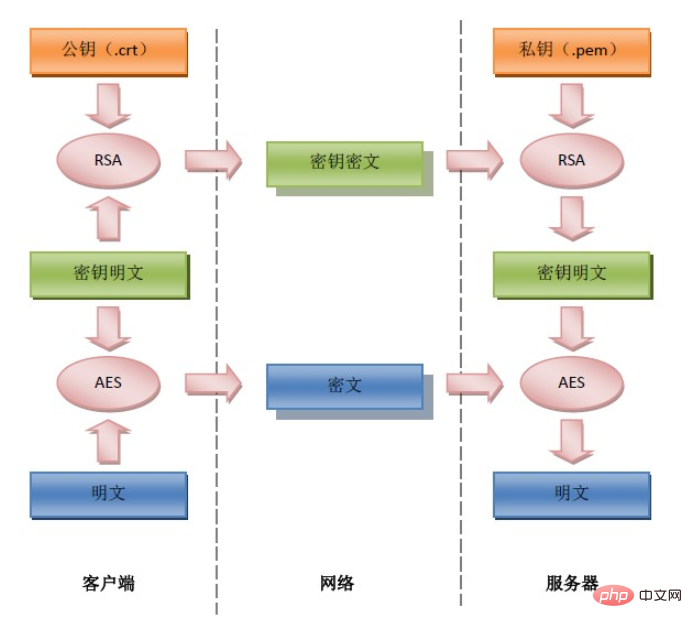互联网上大多数网站,用户的数据都是以明文形式直接提交到后端cgi,服务器之间的访问也大都是明文传输,这样可被一些别有用心之人通过一些手段监听到。对安全性要求较高的网站,比如银行和大型企业等都会使用https对通讯过程进行加密等处理。
但是使用HTTPS的代价是及其昂贵的。不只是CA证书的购买,更重要的是严重的性能瓶颈,解决方法目前只能采用专门的SSL硬件加速设备如F5的BIGIP等。因此一些网站选择了简单模拟SSL的做法,使用RSA和AES来对传输数据进行加密。原理如下图所示:

这样就在一定程度上提高了数据传输的安全性。但是对于大多数网站来说,大部分数据往往没必要搞这么严密,可以选择性地只针对某些重要的小数据进行加密,例如密码。对于小数据量加密来说,可以没必要使用整个流程,只使用RSA即可,这样将大大简化流程。
为什么是小数据量?因为相对于对称加密来说,非对称加密算法随着数据量的增加,加密过程将变的巨慢无比。所以实际数据加密一般都会选用对称加密算法。因此PHP中的openssl扩展公私钥加密函数也只支持小数据(加密时117字节,解密时128字节)。
立即学习“PHP免费学习笔记(深入)”;
网上已有一些AES、RSA的开源Javascript算法库,在PHP中更可直接通过相关扩展来实现(AES算法可以通过mcrypt的相关函数来实现,RSA则可通过openssl的相关函数实现),而不用像网上说的用纯PHP代码实现算法。由于篇幅所限,本文只介绍Javascript和PHP的RSA加密通讯实现,拿密码加密为例。
先上代码:
前端加密
首先加载三个RSA的js库文件,可到这里下载 http://www.ohdave.com/rsa/
$(document).ready(function(){
//十六进制公钥
var rsa_n = "C34E069415AC02FC4EA5F45779B7568506713E9210789D527BB89EE462662A1D0E94285E1A764F111D553ADD7C65673161E69298A8BE2212DF8016787E2F4859CD599516880D79EE5130FC5F8B7F69476938557CD3B8A79A612F1DDACCADAA5B6953ECC4716091E7C5E9F045B28004D33548EC89ED5C6B2C64D6C3697C5B9DD3";
$("#submit").click(function(){
setMaxDigits(131); //131 => n的十六进制位数/2+3
var key = new RSAKeyPair("10001", '', rsa_n); //10001 => e的十六进制
var password = $("#password").val();
password = encryptedString(key, password);//美中不足,不支持汉字~
$("#password").val(password);
$("#login").submit();
});
});PHP加密函数
/**
* 私钥解密
*
* @param string 密文(base64编码)
* @param string 密钥文件(.pem)
* @param string 密文是否来源于JS的RSA加密
* @return string 明文
*/
function privatekey_decodeing($crypttext, $fileName,$fromjs = FALSE)
{
$key_content = file_get_contents($fileName);
$prikeyid = openssl_get_privatekey($key_content);
$crypttext = base64_decode($crypttext);
$padding = $fromjs ? OPENSSL_NO_PADDING : OPENSSL_PKCS1_PADDING;
if (openssl_private_decrypt($crypttext, $sourcestr, $prikeyid, $padding))
{
return $fromjs ? rtrim(strrev($sourcestr), "/0") : "".$sourcestr;
}
return FALSE;
}PHP解密函数
/**
* 私钥解密
*
* @param string 密文(base64编码)
* @param string 密钥文件(.pem)
* @param string 密文是否来源于JS的RSA加密
* @return string 明文
*/
function privatekey_decodeing($crypttext, $fileName,$fromjs = FALSE)
{
$key_content = file_get_contents($fileName);
$prikeyid = openssl_get_privatekey($key_content);
$crypttext = base64_decode($crypttext);
$padding = $fromjs ? OPENSSL_NO_PADDING : OPENSSL_PKCS1_PADDING;
if (openssl_private_decrypt($crypttext, $sourcestr, $prikeyid, $padding))
{
return $fromjs ? rtrim(strrev($sourcestr), "/0") : "".$sourcestr;
}
return FALSE;
}
测试代码
define("CRT", "ssl/server.crt"); //公钥文件
define("PEM", "ssl/server.pem"); //私钥文件
//JS->PHP 测试
$data = $_POST['password'];
$txt_en = base64_encode(pack("H*", $data)); //转成base64格式
$txt_de = privatekey_decodeing($txt_en, PEM, TRUE);
var_dump($txt_de);
//PHP->PHP 测试
$data = "测试TEST"; //PHP端支持汉字:D
$txt_en = publickey_encodeing($data, CRT);
$txt_de = privatekey_decodeing($txt_en, PEM);
var_dump($txt_de);
代码贴完,有几处需要说明一下。其中十六进制公钥的获取是关键。由于密钥从x.509证书中获取,所以要先生成密钥及证书文件(本文中用的1024位密钥),具体生成方法请自行Google :P。这里重点说一下怎么从中获取十六进制的密钥。
从文件中读取十六进制密钥,本人之前尝试了很多方式,网上说数据是用ASN.1编码过的……囧~ 最后无意中注意到linux shell下openssl貌似可以从私钥文件(key或pem)提取。
openssl asn1parse -out temp.ans -i -inform PEM < server.pem
显示结果如下:

从这里终于可以看到Javascript中所需要的十六进制公钥密钥:D
以上就是Javascript 到 PHP 加密通讯的简单实现的详细内容,更多请关注php中文网其它相关文章!

PHP怎么学习?PHP怎么入门?PHP在哪学?PHP怎么学才快?不用担心,这里为大家提供了PHP速学教程(入门到精通),有需要的小伙伴保存下载就能学习啦!

Copyright 2014-2025 https://www.php.cn/ All Rights Reserved | php.cn | 湘ICP备2023035733号